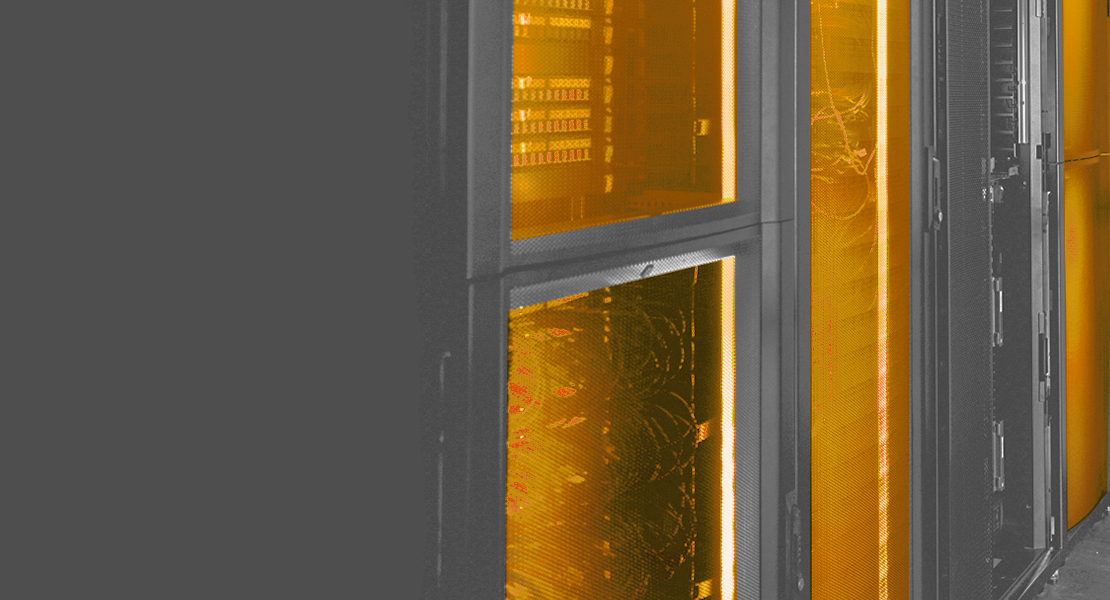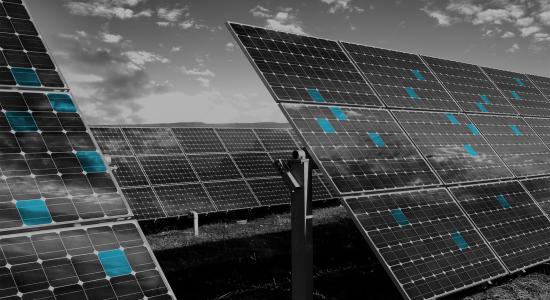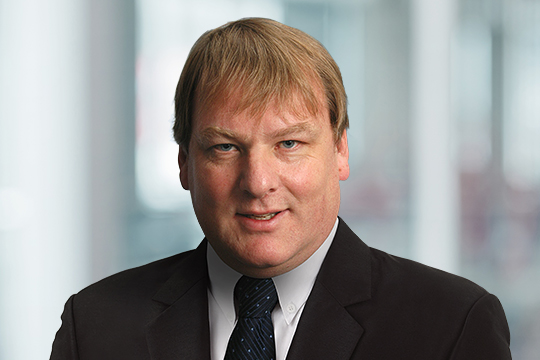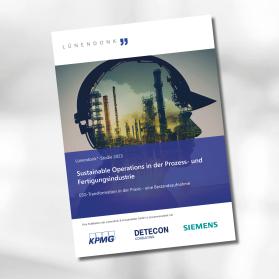Dr. Béla Waldhauser is the chief executive officer of Telehouse Deutschland GmbH and since February 2018 has been spokesman for the Alliance to Strengthen Digital Infrastructures in Germany. He is convinced of the relevance of digital infrastructures for Germany’s economic sustainability in the future and the importance of how “digital sovereignty” is perceived at the political level. During his conversation with Dr. Tim Krüger and Dr. Rainer Weidmann, he outlines the challenges and opportunities that arise on the path to more efficient operation of data centers.
Detecon: What role does green IT play at Telehouse Germany, and what actions has your company taken to become more efficient and sustainable?
Waldhauser: We pay very close attention to our power usage effectiveness value (PUE). We want to be as efficient as possible, and so it is imperative that our customers use cold aisle containment or, in new data centers, hot aisle containment. We typically offer cold aisle temperatures between 22 and 24 degrees Celsius and post a PUE in the newer data centers of about +/- 1.3 – it was a completely different story 20 years ago, when the average PUE was more like 2 or even higher. Back then, we consumed half of the electricity for our own operation – mainly for cooling and air conditioning. Today, the new data centers consume only a quarter the total demand for electricity for us while three-quarters are consumed by our customers. At the moment, the PUE of our legacy systems is 1.6/1.7, and combining them with the newer systems allows us to post an average PUE of 1.5.
In addition to temperature and cold and hot aisle containment, we also strive to operate circulating air cooling units (for example) with frequency control. We use indirect free cooling and adiabatic cooling in the new data center.
We also use similarly modern systems that have a completely different hysteresis curve for our UPS (uninterruptible power supply) systems. One of the greatest issues we have in co-location is that our customers actually use only 50 percent to 60 percent of the contractually agreed services. When capacity utilization is this low, operators are forced to make quite an effort to work efficiently.
In the Alliance to Increase Digital Infrastructure in Germany, for example, we work together with the Ministry of the Environment to promote liquid-cooled servers. Air is not the best medium for heat dissipation, and there is little acceptance of water-cooled racks as well. Liquid is a much better medium for heat dissipation than air. When liquid-cooled servers are in use, the heat is collected and cooled where it is generated – right on the board.
Besides this, I am also a strong advocate of the utilization of waste heat. This is a problem, however, in the air-cooled data centers with indirect free cooling in common use at present. We achieve a maximum of 30 degrees in the waste heat, especially in summer, but not in winter when more heat is needed. Nevertheless, we have signed a letter of intent with the Frankfurt energy supplier Mainova. There is a major project for the construction of 1,300 new residences in Frankfurt, and we have joined the project developer and Mainova in a tripartite alliance. Working together, we want to transport the waste heat from our campus to the other side of the street and feed it into the grid. For its part, Mainova guarantees that the residences will have heat all year round, and we will supply as much of this heat as we can. This is a local heating project that can be realized very effectively. The temperatures we supply are much too low for use in district heating. It would be perfect if we had liquid-cooled servers that produce waste heat at temperatures of 60 to 70 degrees Celsius and that could then be fed into modern district heating networks without any problems. But that is still a vision of the future.
Do you also perform an analysis of the CO2 balance of your company?
We do not consider CO2. I always find that a bit difficult to calculate, at least when it's not the main business. We look at energy consumption, i.e., electricity, water, and diesel, whereby availability is always our primary concern.
Could you please describe in greater detail your green electricity procurement and certificate trading?
That is relatively simple. We are one of Mainova’s customers and have declared that we would like to have this certificate every year. We are given a price quote, and that’s the end of the matter. We do not trade in certificates. But Telehouse handles this differently in each country. We have been procuring green electricity for years. I’ve been managing director in the data center sector for 20 years, and as early as 15 years ago, we had queries about green electricity. But when the subject of costs arose, interest quickly waned. In view of the current market prices for electricity, the purchase of certificates is really the only action that can be taken.
The colleagues in London, for example, participate in the Carbon Trust Program because in England there is closer alignment with the carbon footprint; that is not the case for the data center sector here in Germany. We are more concerned with the PUE, i.e., energy consumption. Electricity costs today account for 50 percent of the costs for our customers in Germany. There is almost nothing we can do to influence procurement because at least two-thirds of the costs of electricity are regulated in Germany. The EEG levy in particular is a major competitive disadvantage for us in Germany as electricity is much cheaper in most other European countries. This is also the reason why the certificates are the only action we take and why we do not buy “genuine” green power. However, sustainability is not the only aspect that requires us to be energy efficient; competition considerations also force us in this direction as our overall package will otherwise be too expensive.
Right now the average PUE is 1.5 while new data centers post 1.3. If growth continues, the average value would probably continue to fall as well. Do you think that your company can realistically reach an average of 1.3 in, say, 10 years?
I definitely think that is realistic. Competitive reasons alone mean we must design the new data centers to be much more energy efficient. The percentage of new data centers will continue to rise disproportionately in comparison with the percentage of legacy data centers. This alone will make us a little more efficient as a whole every year. Of course, we are also working on making the older data centers more energy efficient. But I will say it again: the total power consumption and with it the total CO2-emissions are rising steadily because of the high demand from our customers.
Efficiency is dependent on two important factors:
- The first is growth, i.e., the faster the growth, the higher the proportion of energy-efficient data centers.
- The second is the customers’ utilization of capacities, i.e., if customers consume what they originally contracted, the efficiency of the locations should also increase.
How do you assess the benefits of green IT for Telehouse? Is the competitive advantage through lower costs the only reason, or is the green component along with electricity costs important to some customers after all?
There are now more customers asking about green power. But I guarantee you that if these certificates were no longer available and customers had electricity costs that were 10 percent to 15 percent higher, 80 percent of our customers would decide against it. We are not in any position to put so many solar panels on the roofs or set up enough wind turbines that we can come even close to generating the electricity needed to meet consumption, so we have to procure power.
For all my love of sustainability, I have no illusions about the driving forces behind the customers; their primary concern is the costs.
What would you say about Telehouse’s position in comparison to competitors in terms of climate-friendly IT operation or energy efficiency?
The question about climate-friendly IT operations is not so very relevant in our industry as we do not operate the IT. As far as I know, most of my competitors also procure green electricity and, like us, have the problem that customers utilize no more than 50 percent to 60 percent of the contracted power. I can recommend the 27 degrees Celsius of the ASHRAE cold aisle standard or convince customers to accept it solely in very rare cases. When I operate a data center with a lot of different customers, I must always accept compromises. These compromises are at the expense of sustainability and other benefits.
Moreover, customers demand a high level of redundancy and the related high availability. Every level of redundancy comes at the expense of sustainability. A large company in the public sector in Frankfurt announced a tender. One of the technical requirements was a self-sufficiency period of at least 30, but preferably 45, minutes in case of a power failure. If you use batteries as a buffer, we are typically talking about 10, maybe 15 minutes as a maximum, and it takes thousands of batteries to provide this period. So you can imagine the size of the battery park I would need for a period that is three or four times as long. Sustainability has fallen by the wayside if I need an extra building just for batteries.
What argument do customers have for not accepting the raising of the cold temperature in the cold aisle above 24 degrees?
It’s very simple. If the air conditioning system should ever choke, the temperatures would very quickly rise to a critical point, and customers want a little buffer. Or if you have a delta T of 8 degrees, for instance, you have 27 degrees in the cold aisle and 35 degrees in the hot aisle. This causes considerable discomfort for employees. In the past, if you wanted to enter a data center, you had to put on a heavy jacket because they were kept at Arctic temperatures. Today, you wear shorts and a t-shirt, and it is still too warm. At some point you reach a limit for the employees who work there all the time.
If technology advanced to the point that the additional costs for water cooling were lower, would this be a key factor in achieving a gain in efficiency?
We have today water-cooled racks. These water-cooled racks can be purchased from a number of different manufacturers. But even these racks still use air as the actual cooling medium and never reach 60 to 70 degrees. In addition, most customers still want to avoid the use of water or other liquids in the data center rooms.
In the future, however, we should try to turn to water- or liquid-cooled servers. This equipment would no longer use air as an intermediate medium because the cooling coils are installed directly on the board and the level of waste heat can reach 60 to 70 degrees Celsius. There are several reasons why this is desirable.
- One, liquid is used as cooling medium. It doesn’t necessarily have to be water.
- Second, the heat is collected where it occurs – right on the board.
- Third, waste heat is created at a temperature that can actually be used for other purposes and that can be fed more or less directly into modern district heating networks because they operate at these temperatures. Fourth, this waste heat is generated all year round, i.e., especially in winter, when potential consumers need more heat.
One more important point: if we bring heat pumps into the discussion today, i.e., if I take the waste heat from a data center and try to raise its temperature a little, I pay the full price, including all taxes and the EEG levies, for the electricity. So I try to do something sustainable and am penalized yet again because the electricity for these heat pumps is also too expensive. The Alliance is calling on politicians to provide better framework conditions for the promotion of sustainability.
Thank you for this interesting interview, Mr. Waldhauser!








